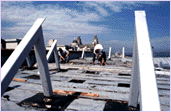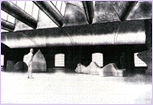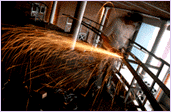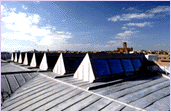



HistoryThe Albert Dock | The Conversion to an Art Gallery | Building on Success | The Programme
The Albert DockThe Albert Dock was opened in 1846 by Prince Albert, after whom it is named. It was designed by Jesse Hartley, a Yorkshire engineer who was appointed Surveyor of Liverpool Docks in 1824. The entire Albert Dock complex stretches for seven acres and warehouses were used to store tea, silk, tobacco and spirits from the Far East. The complex was registered in 1952 as the largest group of Grade 1 Listed buildings in Britain but this did not stop it falling into a state of near dereliction before being finally closed in 1972. Following the Toxteth riots in 1981 Liverpool underwent a dramatic regeneration, with inner-city development projects bringing government support and funding to the city. The Merseyside Development Corporation (MDC) was founded and one of their chief aims was the renovation of the docklands. Tate Liverpool was incorporated into the MDC scheme which converted the Albert Dock to accommodate the Merseyside Maritime Museum (now part of the National Museums and Galleries on Merseyside) as well as shops, offices and apartments.
The Conversion to an Art Gallery
Building on SuccessThe redevelopment of the Gallery was made possible by the award in March 1996 of a grant of £3.8 million from the Heritage Lottery Fund, £1.5 million from the five boroughs of Merseyside from European Regional Development Funds, together with donations from public and private sources. Building work began in November 1996 and the Gallery closed to the public from April 1997 to May 1998.
The ProgrammeTate Liverpool houses two main types of exhibits: art selected from the Tate Collection and special exhibitions of contemporary art (bringing together works loaned from other collections both public and private). Over eighty different presentations have been shown since the Gallery opened and they have included more than 300 different artists. The Gallery has always shown the wide and challenging variety of objects that are included in the field of modern and contemporary art: photography, printmaking, video, performance and installation as well as painting and sculpture. Alongside British art, foreign work has been exhibited (some seen for the first time in this country at Tate Liverpool). The Gallery has worked with institutions in France, Spain, Portugal, Germany, United States of America, Canada, Ireland, Korea and Japan as well as galleries in Great Britain.
|



